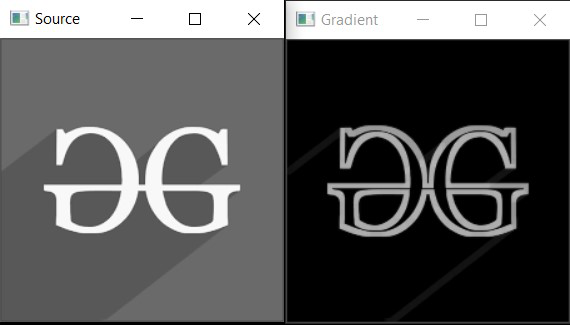在本文中,讨论了一种称为“梯度”的形态运算符。梯度定义为图像的膨胀和侵蚀之间的差异。渐变图像中的每个像素代表一个像素附近的对比度强度。它用于图像分割和边缘检测。它有两种类型:
- 内部渐变:它增强了比背景明亮的对象的内部边界,并且对于二进制图像,生成前景图像对象的内部边界的蒙版。
- 外部渐变:它增强了比背景暗的对象的外部边界。
句法:
morphologyEx (src, dst, op, kernel, anchor, iterations, borderType, borderValue)
参数:
- src:它是输入图像。
- dst:它是输出图像。
- op:形态学操作的类型。
- 内核:用于结束的结构元素。
- 锚:在结构元素内的锚位置。默认值为[-1,-1},表示位置为结构元素的中心。
- 迭代:应用关闭的次数。
- borderType:边框类型(BORDER_CONSTANT,BORDER_REPLICATE等)
- borderValue:边框值
- 返回值:输出图像(垫子对象)
渐变运算符的表达式为:
以下是用于演示渐变形态学操作的C++程序:
C++
// C++ program to demonstrate the
// above approach
#include
#include
// Include this library
// for drawing shapes
#include
#include
using namespace cv;
using namespace std;
// Driver Code
int main(int argc, char** argv)
{
// Reading the Image
Mat image = imread(
"C:/Users/harsh/Downloads/opencv/sources/samples/data/gfglogo.jpg",
IMREAD_GRAYSCALE);
// Check if the image is created
// successfully or not
if (!image.data) {
cout << "Could not open or "
<< "find the image" << '\n';
return 0;
}
// Create a structuring element
int morph_size = 2;
Mat element = getStructuringElement(
MORPH_RECT,
Size(2 * morph_size + 1,
2 * morph_size + 1),
Point(morph_size,
morph_size));
Mat output;
// Gradient
morphologyEx(image, output,
MORPH_GRADIENT, element,
Point(-1, -1), 1);
// Display the image
imshow("Source", image);
imshow("Gradient", output);
waitKey();
return 0;
} 输出: 
要从最佳影片策划和实践问题去学习,检查了C++基础课程为基础,以先进的C++和C++ STL课程基础加上STL。要完成从学习语言到DS Algo等的更多准备工作,请参阅“完整面试准备课程” 。